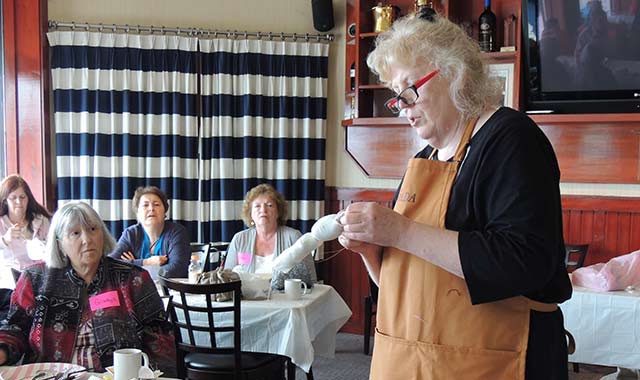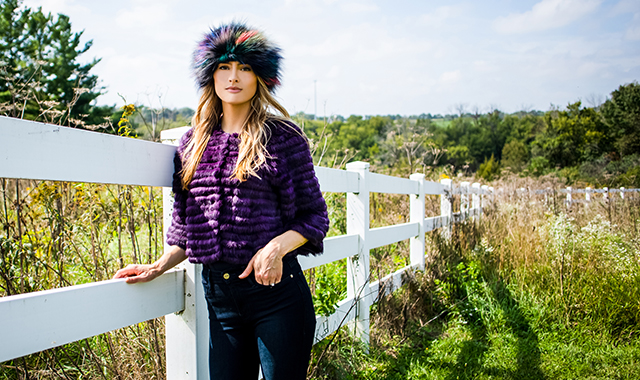Meet the two women behind the Pink Ribbon Doll, a product and workshop series meant to raise money for cancer treatment.

Tomen helping women is the driving concept behind the Pink Ribbon Doll, a product to raise money for cancer detection and treatment for those women who can least afford it.
A doll-making workshop in Fontana, Wis., brought together about 20 doll collectors who stuffed, stitched, painted and dressed dolls. The workshop leader was Susan Fosnot, renowned doll maker, and the designer of the Pink Ribbon Doll named “Hope.”
The inspiration came from Jeanne Chupich, a nurse practitioner and doll collector for more than 30 years, who has worked with Dr. Art Manas in Rockford for 12 years.
“The Pink Ribbon Doll was designed out of respect for women with breast cancer,” says Chupich. “The spirit of women helping women is the goal, as much as it is about raising money to help women pay for detection and treatment. I’m seeing more and more women being diagnosed at an earlier age and it’s a devastating diagnosis. It’s a heartbreaking experience navigating the breast cancer disease path, and I want to do something more to help. Once diagnosed, treatment is overwhelmingly expensive. One hundred percent of the money we raise selling dolls will be used to help women.”
Chupich gathered support from local companies Beef-A-Roo, Mary’s Market and Dean’s Foods to provide food for the event. Oregon Soap Company donated a pink bar of fragrance-free soap to all workshop volunteers.
Both Chupich and Fosnot belong to the Lake County Doll Collectors Club and the United Federation of Doll Clubs (UFDC). The Pink Ribbon Doll is a project of the Lake County Club and the first two workshops were held in Mundelein, where the club meets. Other doll collectors become involved by attending workshops and many volunteers are involved in some part of the doll-making process. Chupich organized the Fontana workshop.
Originally, Chupich had the idea to sell dolls to raise money for breast cancer, but then Fosnot offered to create a specific doll for the cause and donate her time and talent to conduct workshops. All money raised from the doll sales goes to the Silver Lining Foundation, a resource for women who can’t afford mammography and other breast cancer prevention and treatment costs. The foundation was founded in 2002 by Dr. Sandy Goldberg, a cancer survivor and Emmy winner for her role in One Woman’s Story, in which photographers and journalists followed her for 14 months after surgery, for the production of the 13-week NBC series.
Each doll sells for $50. Workshop participants can either donate the doll to be sold or purchase the doll, with proceeds going to the cause. So far, more than 70 dolls have been made or are in the process of being made. Every penny raised goes to the foundation, Fosnot says, adding that the Mundelein club donated $200 for materials to make the dolls. Other donations came in from other area clubs.
The Pink Ribbon Doll is made in a similar, but much simpler, way than the painted cloth dolls Fosnot is known for creating. Her other creations are much more complicated, with intricate details in the clothing and fully painted faces.
“It’s the difference between a sketch and an oil painting,” she explains.
At workshops, Fosnot gives step-by-step instructions to help people achieve just the right look.
“You can’t use too much stuffing,” she tells the workshop attendees, before giving them tips on how to stitch together the top of the head to give it the best shape and how to properly close the body and legs.
The Pink Ribbon Doll is inspired by 1930s doll maker Edith Flack Ackley, who wrote a book on how to make dolls for fun and profit. Her sweet-looking dolls have embroidered faces and hair made from yarn. Fosnot liked the look, but duplicating it was problematic.
“It was very time-consuming,” she says. “I like the 1930s little girl look, but I made changes to make it my own and cut the time in half to make a doll. Basically, I changed everything about the doll except the shape of it.”
Instead of taking the time to embroider a face and attach yarn hair, all features are painted onto the doll’s head. The dress is easier to make, too, she says.
“Each doll has that shy, pretty, sweet 1930s look about her, but at the same time, each one looks different because of the artist’s unique touch,” she says.
Donnell Wisniewski of Sangamon Valley Doll Study Club in Springfield, Ill., has been making doll clothes since she was a child and attended a recent workshop to learn from someone she admires.
“Susan is well-known in doll communities and when I heard she was offering her services here, I just had to come and learn from her,” says Wisniewski.
Bobbi Clark, from Chicago, has been a doll collector for 35 years. She owns a doll made by Fosnot and says she couldn’t pass up the chance to see and learn from an artist whom she admires.
People were drawn to the workshop for other reasons, too.
Jennifer Ladisch-Douglass of Highland Park, was at the workshop. An attorney by profession, she inherited her love of dolls from her mother and has been collecting for 20 years. She has young children and is herself a cancer patient, diagnosed with breast cancer about 10 months ago. Just as shocking as her diagnosis was the awareness she now has about the reality of cancer in women’s lives.
“I’m amazed at how many women have told me about their experiences with breast cancer,” says Ladisch-Douglass. “Multiple women have told me their stories and opened up about what they are experiencing. In general, people don’t talk about their cancer, unless they’re talking to someone who has been through it and understands.”
Ladisch-Douglass currently works with The Licorice Project, an online community for anyone affected by breast cancer, including newly diagnosed patients, survivors, their families and friends. She is working to assemble “treasure boxes” of items that women can use while going through cancer treatment. The baskets will be filled with a blanket, books, food items, picture frames, lip gloss, gum, and other items to help a person get through the day.
“These are items that help us to feel uplifted,” she explains. “Some women feel so alone and lost, yet it’s amazing when you find out how many groups are out there to help women cope with the illness. And it’s not all about just the disease. It’s also about looking for new treatments and cures,” she says.
Ladisch-Douglass knew something was wrong when she experienced sharp, shooting, random pains on the right side of her body. Under 40 years old at the time, she didn’t detect any lumps or masses, and neither did her doctors. The diagnosis was made after a mammogram.
“I’ve learned so much about breast cancer, how many women it affects, and that younger and younger women are being diagnosed,” says Ladisch-Douglass. “Getting a diagnosis and treatment for breast cancer is hard work, but you do have a lot of support, if you choose to seek it out and use it.”



















































